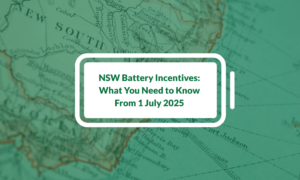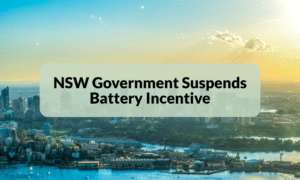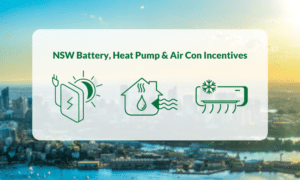New South Wales (NSW), home to over 8.2 million people, is leading the way in solar energy adoption. With more than 1.1 million residential solar panels NSW installations by 2024, many households are benefiting from the state’s abundant sunshine. Solar power is more accessible than ever, with an increasing number of residents opting for battery storage—around 12% of new solar installations now include this feature. This trend is helping homeowners across the state harness solar power NSW, cut electricity bills, and reduce their carbon footprint with the help of NSW solar installers.
Businesses across NSW solar landscape are also embracing clean energy, integrating solar to reduce operational costs and meet sustainability goals. As renewable energy becomes more popular, the NSW government continues to support these efforts through various incentives. Residents and businesses alike can access free solar quotes through Energy Matters to find competitive deals on solar NSW systems, making solar power a smart, sustainable choice for the state’s sunny future.
Get Solar Quotes from up to 3 Local Installers in NSW
Step 1: Complete our step-by-step quote form and we’ll pair you with local, trusted installers
Step 2: You will be contacted by up to 3 local installers via phone and/or email for further details and their best quote.
Step 3: All quotes are free and no-obligation, meaning you are free to choose the best quote that suits your needs and budget.

Read more about solar panels and other renewable energy technology in your area:
On this page
Are solar panels worth the investment? How much money can you save?
If you’re wondering whether solar panels are worth the investment for Sydneysiders, the answer is a resounding yes. Solar panels continue to be one of the smartest and safest investments of 2024. Recent data shows that solar owners in New South Wales are saving an average of 30% on their energy bills compared to households solely relying on the grid. With solar installations more accessible, affordable, and easier to install than ever before, now is the perfect time to maximise your rooftop’s potential.
Whether you live in Sydney, Newcastle, Wollongong, the Central Coast, or any other region in NSW, our partner installers offer the ideal solar energy solution for your needs. Take advantage of government subsidies and fantastic deals on solar systems while they last. Get your free solar quotes today at Energy Matters.
How much do solar panels cost in NSW?
The cost of installing solar panels in NSW can vary depending on the size of the system and other factors like installation complexity and brand choice. As of October 2024, homeowners in New South Wales can expect to pay approximately $4,300 for a 4kW system, $4,920 for a 5kW system, $5,240 for a 6kW system, $6,200 for a 7kW system, and $7,980 for a 10kW system. These prices are reflective of average market rates and include standard installation, the STC discount, and GST. Larger systems typically offer more long-term savings on electricity bills, especially for homes with higher energy usage.
The chart below provides a clear breakdown of the typical costs for different solar system sizes in NSW.
Figures are accurate as of October 2024. Source: Solar Choice – October 2024 solar price index. Your solar system price will vary according to your location, installer, products, and any deals or discounts provided by your retailer. All prices are to be used as a guide.
Top 5 things to consider before installing solar panels in NSW
Solar panels are a smart and sustainable way to generate electricity for your home in New South Wales.
With abundant sunshine and rising energy costs, installing solar panels can help homeowners reduce their energy bills, lower their carbon footprint, and add value to their property. However, before jumping into solar panel installation, there are a few key things that homeowners need to consider to ensure a successful and efficient solar power system for their homes.
1. Assess your home’s solar potential
The first step in determining if solar panels are right for your home in New South Wales is to assess your home’s solar potential. Factors such as the location of your home, the orientation of your roof, shading from nearby trees or buildings, and the angle of your roof can all affect the efficiency of your solar panels. Consulting with a professional solar panel installer who can conduct a thorough site assessment and provide an accurate estimate of your home’s solar potential is crucial.
2. Understand your energy needs
Before installing solar panels, it’s important to understand your home’s energy needs. Assess your current energy consumption by reviewing your past energy bills and determine how much electricity you need to offset with solar power. Consider your future energy needs as well, taking into account any changes in your household size, energy usage patterns, or plans for electric vehicle charging. This information will help you determine the size of the solar panel system you need for your home.
3. Research solar products and manufacturers
With countless solar panels, inverters, batteries, and other solar components available, it is important to do your research. Consider a product’s warranty, lifespan, efficiency, functionality, and performance. Energy Matters recommends products to our residential and commercial customers that have been vetted and scrutinised for longevity and return on investment.
4. Consider financing options
Solar panel installation is an investment, and homeowners need to consider their financing options. Several options are available, including purchasing solar panels outright, financing through a solar loan, or opting for a solar lease or power purchase agreement (PPA). Each option has pros and cons, and homeowners should carefully evaluate the costs, benefits, and risks associated with each option based on their financial situation and long-term goals.
5. Research solar panel installers
Choosing a reputable and experienced solar panel installer is crucial for a successful solar panel installation. Research different NSW solar installers, read customer reviews, and ask for recommendations from friends or neighbours who have installed solar panels. Look for installers who are accredited, licensed, and have a proven track record of quality installations. Request quotes from multiple installers and compare their offerings, including the type and quality of solar panels, warranties, and pricing, to make an informed decision.
“We recently had EM chosen partner build an 8+kW system and battery for us. From the beginning, they were outstanding in terms of service, counsel, cost, installation, and follow-up. Each member of the personnel, including the entire installation team, was kind, knowledgable, and punctual.”
Kài Rune
“Strongly advise using Energy Matters for your solar energy quotes. Their consultants, and solar companies provided excellent insight and advice to make sure we got the most appropriate system, lots of different options, and I was very happy with every element of their service delivery.”
Amber
“I really recommend Energy Matters. They helped me find the right company to install my solar system”
Chris
Make money by saving money
For a 6.6kW solar system in New South Wales, homeowners can expect to save between approximately $1,250 and $1,600 per year, depending on their electricity usage and whether they have a battery. This estimate assumes a current feed-in tariff (FiT) between 4.9 and 6.3 cents per kilowatt-hour (kWh) and typical electricity consumption of solar-produced energy
For a larger 10kW system, the estimated savings increase to around $2,000 to $2,500 annually, particularly for homes with higher self-consumption or those using time-of-use tariffs. This makes both system sizes attractive investments in reducing energy costs across New South Wales.
Reducing home energy bills in NSW
NSW faces rising energy costs, prompting homeowners to seek effective solutions. Solar panel installation has gained popularity as an effective way to reduce energy bills significantly. With abundant sunshine, particularly in Sydney, solar panels generate substantial electricity, allowing homeowners to offset grid consumption and lower their bills. Although the initial investment may seem high, the long lifespan of solar panels (25 to 30 years) and the savings they generate can make them a worthwhile long-term investment.
Beyond financial benefits, solar panels contribute positively to the environment by reducing greenhouse gas emissions and fostering sustainability. Homes equipped with solar panels are often more attractive to buyers, increasing property value and marketability. This makes solar panels not just a means of cutting costs, but also a smart investment that enhances home appeal in the competitive real estate market, benefiting both homeowners and the environment in NSW.
NSW rebates and incentives
New South Wales residents and businesses can benefit from a range of state and federal incentives and rebates, including:
- Small-scale Technology Certificates (residential and small-medium businesses)
- Large-scale Generation Certificates (large businesses)
- Feed-in Tariffs
- Battery incentives (from 1 November 2024)
Find out more about these programs and initiatives via the button below.
Energy efficient products and upgrades
Upgrade and swap out your inefficient appliances and products with the latest energy-efficient technology. Your hot water system, heating and cooling system, and various other household appliances might just be costing you thousands extra each year to run. Replacing these could save you thousands whilst reducing your environmental footprint.
On average, a solar hot water system in New South Wales can save a household between $300 and $700 per year on energy bills, depending on the household’s hot water usage and the type of system installed. These savings are primarily due to the reduction in electricity or gas usage, as solar hot water systems use the sun’s energy to heat water.
For larger households or homes with higher hot water demand, the savings can be even greater. Additionally, these systems help reduce reliance on the grid, making them both cost-effective and environmentally friendly.
New South Wales solar batteries: The future of renewable energy
In New South Wales, 12% of all new solar systems were installed with a battery during 2024. Enjoy power savings day and night by adding battery storage. Not only will solar panels and a battery add value to your home, but they also help minimise your power bills and make you less reliant on the grid.
Touted as the future of electricity, batteries allow solar power generated during the day to be stored for use at night time or on cloudy days when solar panels cannot generate electricity. In fact, adding a battery to a residential solar system can double the amount of self-generated electricity consumption.
Put your battery to work and join a Virtual Power Plant (VPP). Reduce the payback period for your battery investment and make extra money by selling your stored energy to the grid during peak periods.
Find out more about the Origin Loop VPP.
The Electric Vehicle (EV) revolution is gaining strength in Australia. Are you EV ready?
Did you know that over 50% of Australians intend to purchase an EV in the next 5 years? Installing a home battery gives you the flexibility to either sell your stored electricity back to the grid or charge your EV overnight (whichever option works better for you depending on feed-in-tariff, lifestyle, etc.). Residential EV charging allows you to turn your home into your own charging station – reducing your vehicle costs and increasing your convenience.
Making solar simple
We understand one of the major blocks to go solar can be the perceived hassles and headaches. Energy Matters‘ partners will tailor a solution to your needs and assist you every step of the way. Wherever you live in NSW, you can request up to 3 solar quotes from trusted local installers who can discuss your requirements and any questions you may have about making the switch to solar!
NSW solar and battery FAQs
Solar panels can reduce electricity bills, increase property value, and contribute to a cleaner environment by harnessing renewable energy.
Solar batteries store excess energy generated by solar panels during the day, allowing homeowners to use this energy during the evening or when the sun isn’t shining.
Yes, the NSW government will be commencing the battery incentive program from 1 November 2024 to encourage battery installations. The federal government has incentivised the uptake of solar and battery storage with the STC and LGC program.
Savings vary based on energy usage and system size, but many homeowners report reductions of 30% to 50% in their electricity bills after installing solar and batteries.
The required battery size depends on your energy consumption patterns, the size of your solar system, and whether you want backup power during outages. A NSW solar installer can help determine the best size for your needs. In addition, you can check out our handy solar + battery calculator to give you some insight.
Generally, renters cannot install solar systems without landlord approval. However, some companies offer solar leasing options that may be available to renters. It is worth exploring your options with your landlord.
Solar panels generally require minimal maintenance, mainly keeping them clean and ensuring no debris blocks sunlight. Batteries may require periodic checks to ensure they are functioning correctly.
Solar panels typically last 25 to 30 years, while most batteries have a lifespan of 5 to 15 years, depending on the type and usage patterns. Regular maintenance can help extend their lifespan.
NSW news and updates
Keep up to date with the latest renewable news and updates from New South Wales.










































